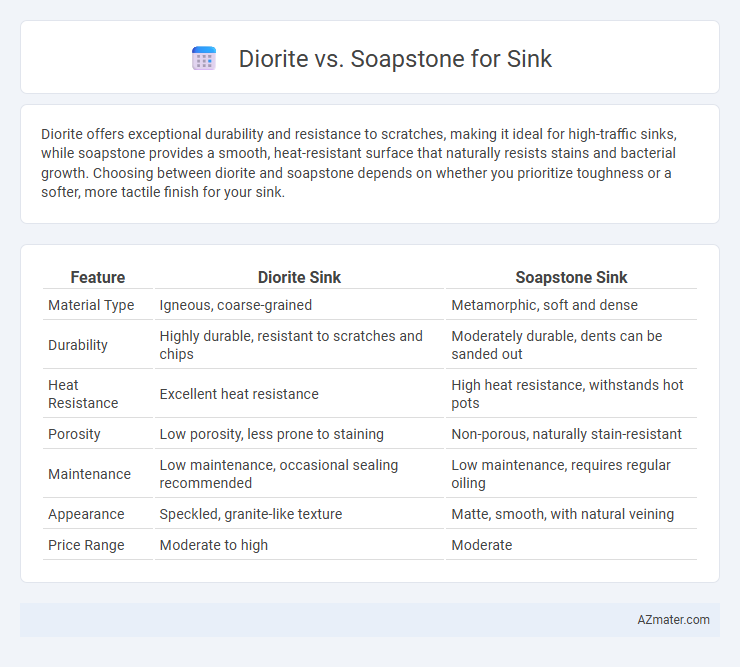Diorite offers exceptional durability and resistance to scratches, making it ideal for high-traffic sinks, while soapstone provides a smooth, heat-resistant surface that naturally resists stains and bacterial growth. Choosing between diorite and soapstone depends on whether you prioritize toughness or a softer, more tactile finish for your sink.
Table of Comparison
| Feature | Diorite Sink | Soapstone Sink |
|---|---|---|
| Material Type | Igneous, coarse-grained | Metamorphic, soft and dense |
| Durability | Highly durable, resistant to scratches and chips | Moderately durable, dents can be sanded out |
| Heat Resistance | Excellent heat resistance | High heat resistance, withstands hot pots |
| Porosity | Low porosity, less prone to staining | Non-porous, naturally stain-resistant |
| Maintenance | Low maintenance, occasional sealing recommended | Low maintenance, requires regular oiling |
| Appearance | Speckled, granite-like texture | Matte, smooth, with natural veining |
| Price Range | Moderate to high | Moderate |
Introduction to Diorite and Soapstone Sinks
Diorite and soapstone sinks offer durable and aesthetically pleasing options for kitchens and bathrooms, each with unique mineral compositions and characteristics. Diorite, an igneous rock known for its hardness and speckled appearance, provides excellent resistance to scratches and heat, making it ideal for heavy-use areas. Soapstone, a softer metamorphic rock rich in talc, features a smooth, matte finish that develops a natural patina over time, offering both beauty and functional resistance to stains and bacteria.
What is Diorite? Key Properties
Diorite is a coarse-grained igneous rock composed mainly of plagioclase feldspar and hornblende, known for its durability and resistance to scratching. Its dense, hard surface makes it an excellent choice for sinks, offering high heat resistance and minimal porosity that helps prevent staining. Compared to soapstone, diorite is harder and less prone to surface etching, making it suitable for heavy use in kitchen environments.
What is Soapstone? Key Properties
Soapstone is a natural metamorphic rock primarily composed of talc, which gives it a smooth, soft texture and a unique, warm appearance ideal for sinks. Key properties include high resistance to heat, stains, and bacteria, making it hygienic and durable for kitchen and bathroom use. Its non-porous surface requires minimal maintenance while offering excellent longevity compared to other stone materials like diorite.
Aesthetic Differences: Diorite vs Soapstone
Diorite features a speckled, granular appearance with a mix of black, white, and gray minerals creating a bold, textured aesthetic, while soapstone offers a smooth, matte finish with a softer, muted color palette ranging from light gray to deep green. Diorite's polished surface highlights its natural crystalline structure, ideal for modern kitchens seeking a striking visual impact. Soapstone's subtle veining and warm, earthy tones provide a timeless, rustic look that ages gracefully with use, developing a unique patina over time.
Durability and Maintenance Comparison
Diorite offers exceptional durability with high resistance to scratches, heat, and stains, making it ideal for heavy-use kitchen sinks requiring minimal maintenance. Soapstone, while softer and more prone to scratches, develops a natural patina over time that enhances its aesthetic appeal, and it requires regular oiling to maintain its moisture resistance and surface integrity. Choosing between diorite and soapstone depends on the balance between long-term durability needs and preferred maintenance routines.
Resistance to Staining and Heat
Diorite exhibits superior resistance to heat with its dense, igneous composition, making it ideal for sinks exposed to hot cookware or liquids. Soapstone, while also heat resistant, is more prone to staining due to its softer, more porous nature and talc-rich content, requiring regular sealing to maintain appearance. Both materials offer durability, but diorite's stain resistance is higher, making it more suitable for high-traffic kitchen environments.
Environmental Impact and Sustainability
Diorite sinks have a lower environmental impact due to the stone's natural abundance and durability, reducing the need for frequent replacements. Soapstone, while also durable, is often praised for its non-toxic properties and minimal chemical processing, making it a sustainable choice for eco-friendly kitchens. Both materials are recyclable and biodegradable, but sourcing local soapstone can further decrease carbon emissions associated with transportation.
Installation and Cost Factors
Diorite sinks demand professional installation due to their hardness and density, which complicates cutting and fitting, often increasing labor costs. Soapstone sinks are easier to shape and install because of their softer composition, allowing for more DIY-friendly options and lower installation expenses. Cost-wise, diorite is generally pricier both in material and installation, while soapstone offers a more budget-friendly alternative with moderate durability.
Best Applications: Which Sink for Which Space?
Diorite sinks excel in kitchens and commercial spaces due to their durability and resistance to heat and scratches, making them ideal for heavy use. Soapstone sinks are perfect for rustic or farmhouse bathrooms and kitchens, offering a smooth, non-porous surface with natural antimicrobial properties that age gracefully over time. Both materials require sealing, but soapstone's softer texture suits gentle cleaning areas, while diorite withstands rigorous daily tasks.
Conclusion: Choosing Between Diorite and Soapstone
Diorite offers exceptional durability and a striking speckled appearance, making it ideal for high-traffic kitchen sinks requiring long-lasting strength. Soapstone provides a smooth, heat-resistant surface with natural antibacterial properties, favored for its warm, matte finish and ease of maintenance. Selecting between diorite and soapstone depends on prioritizing either robust durability and a polished look versus a softer, more tactile surface with natural resistance to heat and stains.

Infographic: Diorite vs Soapstone for Sink
 azmater.com
azmater.com